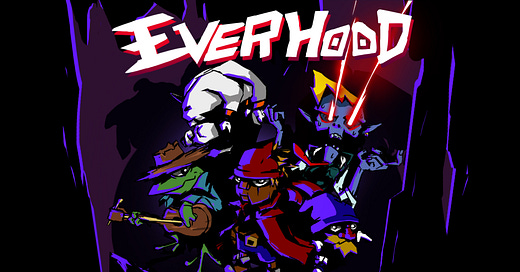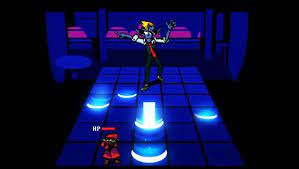Everhood: An Ineffable Tale of the Inexpressible Divine Moments of Truth
Intertextual Weirdness
I’m the sort of person who tends to research things before trying them, but when a friend sent me a copy of a game I never heard of for my birthday, I had a rare chance to truly experience something with no foreknowledge. That game is Everhood: An Ineffable Tale of the Inexpressible Divine Moments of Truth. And it was quite the experience.
Everhood places you in the role of an animate yet silent puppet named Red, who is trying to reclaim their right arm after it was stolen. This quest takes you across different parts of the game’s strange world, with you meeting equally strange and quirky inhabitants.
The word strange cannot be used enough to describe this game. For example it’s often called an RPG, but the battles are more akin to a rhythm game or bullet hell. You move Red between five lanes to dodge attacks until you reach the end of the song, no counterattacking. And some of these battles end up featuring bizarre visuals.
But it’s not strange just to be strange. The game is heavily narrative focused, everything has a point to it. Which makes it hard to discuss the game without spoiling it. So I’m going to do that. If you want to experience the game with minimal knowledge, stop reading here and go get it.
What I will say before the spoiler cut off is that the game has a fascinating intertextual relationship with Undertale, which is what I’m mainly drawn towards discussing. So this post will also include Undertale spoilers.
Spoilers beyond this point, and not just for Everhood but Undertale as well. Final warning.
The gameplay revolving around dodging without making an attack yourself is also how the pacifist route in Undertale works. Except in Undertale the point was that you were purposefully neglecting the attacking side of the gameplay systems to focus on non-lethal options, where here in Everhood the system is built around just dodging. As I was playing I went to myself ‘oh this is Undertale’s pacifist route as its own game.’
Then you reclaim Red’s arm. The credits play, only to stop, as the frog man who gave you a tutorial at the start of the game appears to give you another one about how to attack.
Red’s right arm has the power to kill the immortal denizens of the world of Everhood. By fleeing from death the immortals have locked themselves into endless suffering outside the cycle of life and death, and it is Red’s responsibility to give them salvation by killing every single character you’ve met on the journey.
This half of the game made me deeply uncomfortable in the best of ways. Most of the characters aren’t going to just let you kill them, they’ll fight for their lives. And every time, you have to select the option from the menu to kill them, each kill is a choice you make. At one point even the cursor you use to navigate menus and make choices can turn against you.
I understood the game’s narrative, that killing was the option in line with it, because it was about the importance of mortality. Yet I kept wanting an alternative, keeping a back up save just in case the game pulled a fast one on me and I had made the wrong choice.
But the game stuck to its message, and is all the better for it. To put it bluntly, no AAA game studio could make Everhood, because they’d never be willing to go so far, to go against the standard feel good options. To make pacifism the cowardly and selfish choice.
By the end of the game the world itself has died, and Red faces off against the angry spirits of most of the cast. When the onslaught proves too much, Pink, a character who has been seen in mysterious contexts, appears to defend Red. Only for the other characters to reveal that Red wasn’t the one who killed everyone, it was Pink, who made an illusion of Red to escape responsibility and is the character you spent most of the game actually controlling.
Pink ends up in a blank void, and directly calls upon the player to guide them once more, lacking courage for themself. This courage is needed for Pink to face their own mortality and die. The game then shows the entire cast gathered in the afterlife, having realized there’s more to existence than they know, something beyond death. And a Buddha appears to guide them all into the next phase of existence.
Now it’s time to talk about Undertale again, because the second half of the game is a fascinating contrast with Undertale’s genocide route. Undertale is a very meta game. The genocide route, where the player kills every single character they can with the world ultimately being destroyed, is essentially a commentary on level grinding and the urge of players to seek out all options in a game.
Undertale and Everhood are also linked by plot twists concerning the role of the player’s involvement and who you play as. In Undertale it is revealed that the character named at the start of the game and the one you play as are not the same. In true pacifist this comes out from the player character stating their real name, in the genocide route the character you named reveals themself and seizes control from you.
While both games place emphasis on player agency for their kill everyone options, in Undertale this is used to comment on video game conventions, directly holding the player accountable for their choices. In Everhood, Pink blaming Red and the player is merely their attempt to deny their own responsibility, and Pink ultimately requests help from the player in the ending.
The reason these narratives work so well together is precisely because they do very different things with their similar concepts. Undertale’s genocide route and Everhood’s normal route are parallel in that they never truly intersect, they’re ultimately talking about different things.
With how Undertale itself is influenced by Earthbound and other games, there are likely lines that could be drawn between Undertale’s inspirations themselves and Everhood as well. But I’ve only played a bit of Earthbound so that’s beyond me at the moment.
I struggle to think of other games where the narrative has an intimate relationship with another game’s narrative that isn’t also from the same creator or series. Not ‘look isn’t this just like that hit 90s video game’ but ‘do you see how this indie game parallels the narrative of Final Fantasy VII on a structural level.’
Thinking about this also led me to finding the Aeneid and Everhood similar in how they handle drawing on other narratives. Like how Everhood goes from pacifist Undertale to genocide Undertale, the Aeneid starts as an inverse Odyssey and ends as an inverse Iliad, changing the parallels as the narrative progresses.
Everhood has a lot about it to discuss that doesn’t depend on other games, the intertextual parts are simply what I wanted to write about the most even before I finished the game. There’s more about it I could say, but it’d be better not to cram them all into one post.
A sequel to Everhood is currently in development, so I hope it stays true to itself rather than trying to seek out the mythical wider audience. Regardless, the original will remain as something ineffable and inexpressible, something that you should definitely experience for yourself.




